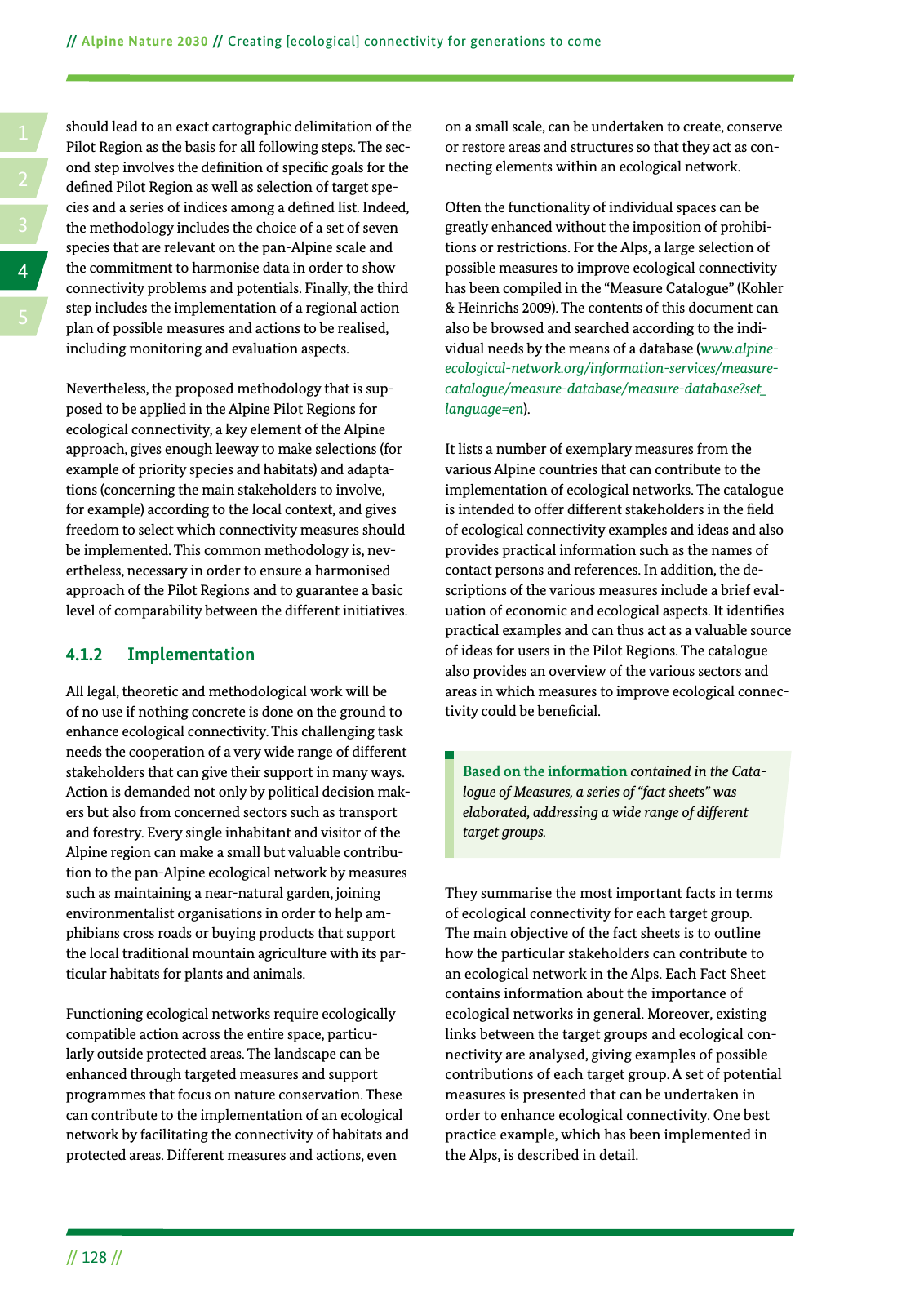14 2 5 3 Alpine Nature 2030 Creating ecological connectivity for generations to come 128 should lead to an exact cartographic delimitation of the Pilot Region as the basis for all following steps The sec ond step involves the de nition of speci c goals for the de ned Pilot Region as well as selection of target spe cies and a series of indices among a de ned list Indeed the methodology includes the choice of a set of seven species that are relevant on the pan Alpine scale and the commitment to harmonise data in order to show connectivity problems and potentials Finally the third step includes the implementation of a regional action plan of possible measures and actions to be realised including monitoring and evaluation aspects Nevertheless the proposed methodology that is sup posed to be applied in the Alpine Pilot Regions for ecological connectivity a key element of the Alpine approach gives enough leeway to make selections for example of priority species and habitats and adapta tions concerning the main stakeholders to involve for example according to the local context and gives freedom to select which connectivity measures should be implemented This common methodology is nev ertheless necessary in order to ensure a harmonised approach of the Pilot Regions and to guarantee a basic level of comparability between the different initiatives 4 1 2 Implementation All legal theoretic and methodological work will be of no use if nothing concrete is done on the ground to enhance ecological connectivity This challenging task needs the cooperation of a very wide range of different stakeholders that can give their support in many ways Action is demanded not only by political decision mak ers but also from concerned sectors such as transport and forestry Every single inhabitant and visitor of the Alpine region can make a small but valuable contribu tion to the pan Alpine ecological network by measures such as maintaining a near natural garden joining environmentalist organisations in order to help am phibians cross roads or buying products that support the local traditional mountain agriculture with its par ticular habitats for plants and animals Functioning ecological networks require ecologically compatible action across the entire space particu larly outside protected areas The landscape can be enhanced through targeted measures and support programmes that focus on nature conservation These can contribute to the implementation of an ecological network by facilitating the connectivity of habitats and protected areas Different measures and actions even on a small scale can be undertaken to create conserve or restore areas and structures so that they act as con necting elements within an ecological network Often the functionality of individual spaces can be greatly enhanced without the imposition of prohibi tions or restrictions For the Alps a large selection of possible measures to improve ecological connectivity has been compiled in the Measure Catalogue Kohler Heinrichs 2009 The contents of this document can also be browsed and searched according to the indi vidual needs by the means of a database www alpine ecological network org information services measure catalogue measure database measure database set language en It lists a number of exemplary measures from the various Alpine countries that can contribute to the implementation of ecological networks The catalogue is intended to offer different stakeholders in the eld of ecological connectivity examples and ideas and also provides practical information such as the names of contact persons and references In addition the de scriptions of the various measures include a brief eval uation of economic and ecological aspects It identi es practical examples and can thus act as a valuable source of ideas for users in the Pilot Regions The catalogue also provides an overview of the various sectors and areas in which measures to improve ecological connec tivity could be bene cial Based on the information contained in the Cata logue of Measures a series of fact sheets was elaborated addressing a wide range of different target groups They summarise the most important facts in terms of ecological connectivity for each target group The main objective of the fact sheets is to outline how the particular stakeholders can contribute to an ecological network in the Alps Each Fact Sheet contains information about the importance of ecological networks in general Moreover existing links between the target groups and ecological con nectivity are analysed giving examples of possible contributions of each target group A set of potential measures is presented that can be undertaken in order to enhance ecological connectivity One best practice example which has been implemented in the Alps is described in detail

Hinweis: Dies ist eine maschinenlesbare No-Flash Ansicht.
Klicken Sie hier um zur Online-Version zu gelangen.
Klicken Sie hier um zur Online-Version zu gelangen.